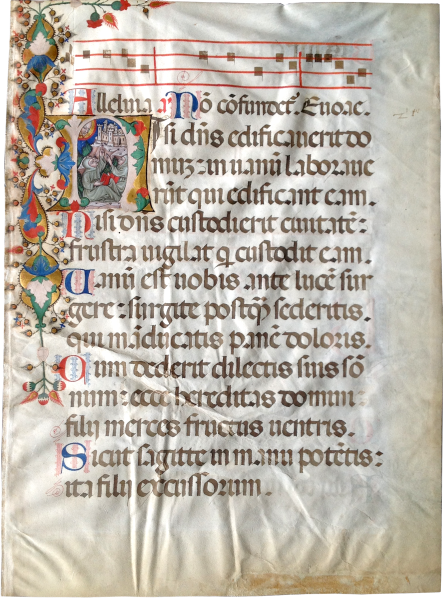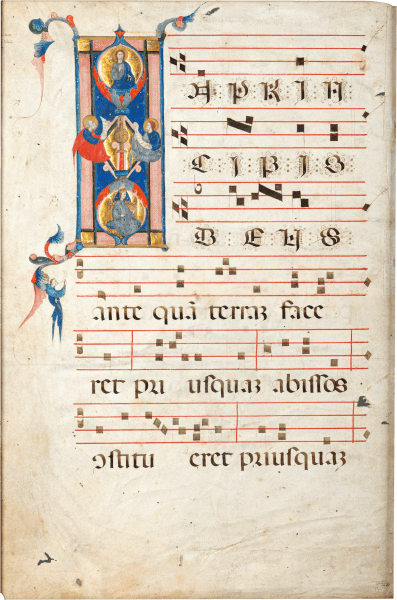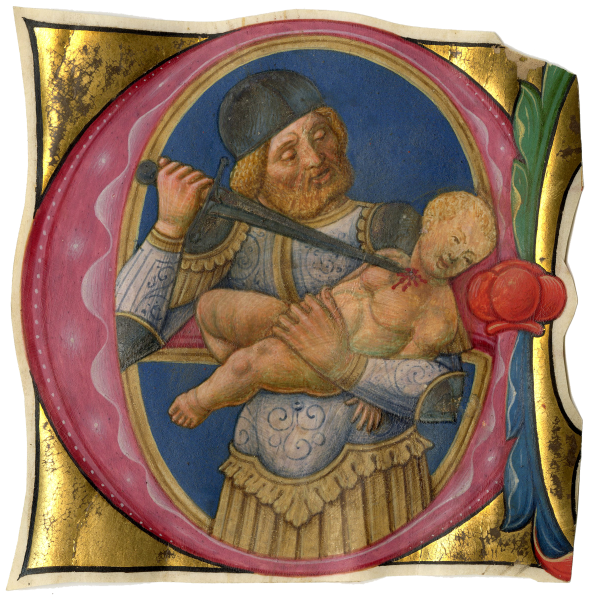Follower of Giovanni di Ugolino Beatus leaf from a Psalter Hymnal



Follower of Giovanni di Ugolino
, Italy, Abruzzi, L’Aquila, c. 1456–1460Follower of Giovanni di Ugolino
Description
The Beatus initial, composed of colorful foliage on a luxurious mosaic ground of gold and vivid colors, presents King David playing the psaltery in the upper counter and Saint Francis in the lower counter displaying scrolls to the three Franciscan orders: friars, nuns, and tertiaries. The miniature provides an unusually rich collection of Franciscan saint portraits in the margins. In the top left, Saint Louis of Toulouse, identified by mitre and crozier and a mantle embroidered with fleurs-de-lys; bottom left, Saint Julian, fashionably dressed with a falcon and sword. In the lower register from left to right: Saint Anthony of Padua holding a book and a green branch; Saint Bernardino of Siena preaching; Saint John of Capestrano (Abruzzi) holding a banner and a book inscribed Domine in nomine tuo, inimici; and, lastly, Saint Clare. The attribute of Saint Bernardino of Siena, a medallion with monogram of Christ “YHS” on a blazing sun, occupies the center of the bottom register.
The presence of Saint Bernardino of Siena, who died in 1444 and was canonized in May 1450, and of John of Capestrano, who died in 1456 (but was not canonized until the seventeenth century), as well as the costume of Saint Julian the Hospitaller, a brief pourpoint in fashion from c. 1455 (cf. Gil 2006, p. 209), date this leaf to c. 1456–1460. The manuscript was likely made for the prestigious monastery of San Giuliano, the first Franciscan monastery founded in L’Aquila, who hosted the General Chapter of the Osservanza in 1452. The monumental dimensions of the leaf and the form of the script indicate that it was intended for use by the choir, likely as part of the Ferial Psalter with hymns, psalms, and antiphons for celebrating the canonical hours. On the recto of our leaf is the explicit of the hymn for Sunday Matins from Trinity Sunday to Advent Praestet hoc nobis deitas beata patris and on the verso, Psalm 1:1–3: Beatus vir qui non abiit in consilio impiorum.
The Beatus leaf features the inventive and eclectic style of Abruzzo painting, which melded local traditions with elements from Lombardy, Tuscany, and the Veneto. Our painter was a follower of Giovanni di Ugolino who, in Alessandro Tomai’s analysis, was responsible for the fresco program in the choir vault of Santa Maria della Rocca in Offida (figs. 1–2; Tomai 2013). Once attributed to the Maestro del Giudizio di Loreto Aprutino (Pasqualetti 2006), the Offida frescos exhibit a similar taste for ornamentation and physiognomic accentuation as our leaf. A comparison with a painting of the Virgin and Child for the Missale de Firmonibus signed by Ugolino in 1436, (fig. 3) reveals similar figural expressiveness, physiognomy, and decorative ornamentation in a vivid palette of blues, pinks, and oranges. Originally from Milan, Ugolino is known to have worked with an illuminator from Le Marche on the Missale and may have even receive his artistic training in Le Marche (Ciardi Dupré Dal Poggetto 1998; De Marchi 2000, 68). Though executed several decades following the Offida frescos, our painter was clearly aware of Ugolino’s work, incorporating many of the artists figural and decorative mannerisms in this composition.
Provenance:
Alan G. Thomas (d.1992), book-seller and collector: owned by him at least as early as May 1960 when he received a letter about the leaf from the Department of Manuscripts at the British Museum; retained in the family and thus not included in his posthumous sale in June 1993
We are grateful to Gaudenz Freuler for expertise.
Literature:
Unpublished; for comparisons and further reading, see:
Ciardi Dupré Dal Poggetto, M.G. “Giovanni di Ugolino da Milano e miniatore marchigiano, Messale de Firmonibus,” in Fioritura tardogotica nelle Marche, ed. P. Dal Poggetto, Milan, 1998, pp. 316–318.
De Marchi, A. “Gotico internazionale: Da Nicolò di Pietro a Michele Giambono,” in Pittura veneta nelle Marche, ed. V. Curzi, Cinisello Balsamo, 2000, p. 85.
Gil, M. “D’Italie du nord en Artois, le portrait de saint Bernardin de Sienne des Heures d’Antoine de Crèvecœur, vers 1450–1455: Leeds, University Library, The Brotherton Collection, Ms. 4,” in Tributes in Honor of James H. Marrow: Studies in Painting and Manuscript Illumination of the Late Middle Ages and Northern Renaissance, ed. by J. F. Hamburger and A. S. Korteweg, London, Turnhout, 2006, pp. 207–218.
Manzari, F., et al. Illuminare l’Abruzzo: Codici miniati tra Medioevo e Rinascimento, Pescara, 2012.
Pasqualetti, C. "Per la pittura tardogotica ai confini settentrionali del Regno di Napoli: Sulle tracce del ‘Maestro del Giudizio di Loreto Aprutino,’ pt. I," Prospettiva 109 (2004), pp. 2–26.
Pasqualetti, C. "Per la pittura tardogotica ai confini settentrionali del Regno di Napoli: sulle tracce del ‘Maestro del Giudizio di Loreto Aprutino,’ pt. II," Prospettiva 117/118 (2006), pp. 63–99.
Salvoni Savorini, G. “Monumenti della Miniatura negli Abruzzi,” Storico Abruzzese-Molisano, Casalbordino, 1935, pp. 495–515.
Tomai, A. “Qualche precisazione sugli affreschi tardogotici in Santa Maria della Rocca a Offida,” in Civila urbana e committenze artistiche al tempo del Maestro di Offida (Secoli xiv–xv), ed. S. Maddalo and I.L. Sanfilippo, Rome, 2013, pp. 329–38.


